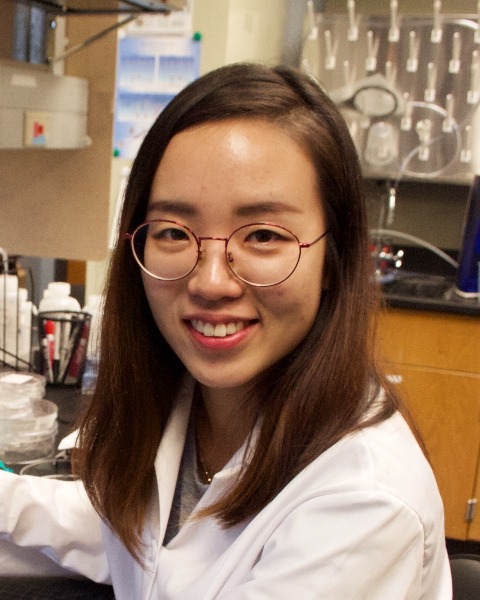Back
On-demand recording will be available 24hrs after the presentation.
Cellular Technologies
Cellular advancements using Organoid and Organ-on-a-chip technology
Advanced Intestinal 3D Morphogenesis by Physiodynamic Reprogramming at Single Cell Resolution in a Human Gut-on-a-Chip
Monday, February 7, 2022
2:00 PM – 2:30 PM
Location: 210A

Woojung Shin, PhD
Postdoctoral Fellow
Wyss Institute At Harvard University, Massachusetts, United States
The establishment of a reliable and translational in vitro human intestine model is still a pressing need in biomedical research, especially given the complicated microenvironment involving host-microbiome crosstalk. One of the challenging components to model the intestine is its unique crypt-villus three-dimensional (3D) structure necessary for demonstrating intestinal homeostasis, microbial niche formation, and spatially localized cellular functions. However, conventional static cell cultures often do not offer differentiated cellular phenotypes and accessible 3D mucosal interface lacking mechanobiological milieu. In contrast, the microphysiological human gut-on-a-chip has innovated the concept of in vitro 3D recreation by which cells cultured in a gut-on-a-chip demonstrates a robust and spontaneous morphogenesis process. The in vitro morphogenesis not only enabled us to closely emulate in vivo microarchitecture but also reprogrammed cells to exhibit lineage-dependent cytodifferentiation, tissue-specific histogenesis, and reprogrammed intestinal functions.
Here, we discuss a mechanistic background of 3D intestinal morphogenesis, single-cell transcriptomics, spatial visualization of cell type-specific differentiation, and applicability of intestinal organoids in the human gut-on-a-chip. We also demonstrate the implementability of the explained mechanism of in vitro 3D morphogenesis for developing a scalable multiplex high-throughput screening system. The gut-on-a-chip that contains two microchannels compartmentalized by a flexible porous membrane provides a defined space and actuatable dynamic milieu to emulate the physiological intestinal microenvironment. By independently manipulating each biomechanical (shear, flow, deformation) or biochemical factor (nutrient, oxygen, antibiotics) in a gut-on-a-chip, we found that this microphysiological control contributes to perturb biophysical cues and morphogen gradients on a polarized intestinal epithelium. The critical driver for the in vitro morphogenesis was the removal of Wnt antagonists such as Dickopf-1 in the basolateral compartment. For scalable multiplex dissemination, we expanded our new finding in a Transwell platform by applying basolateral fluid in a Transwell-insertable hybrid microfluidic device or a multi-well insert platform to robustly grow 3D intestinal epithelium in vitro.
Based on the uncovered mechanism, we elucidated cellular fidelity at transcriptomic and phenotypic levels. We found that the enterocyte-specific Caco-2 cells represent reprogramming in lineage-dependent differentiation and unprecedented cellular functions such as cytochrome P450-based drug metabolism in a gut-on-a-chip. The 3D microarchitecture revealed cell migration of proliferative cells in a crypt-villus axis, reminiscent of the cellular behavioral dynamics in vivo. Most importantly, transcriptomic evolutionary process was discovered by a single-cell RNA sequencing followed by visual mapping of representative genes in subclusters with increased cellular heterogeneity. Single-cell transcriptomics revealed that not only essential intestinal functions but also cancerous characteristics of Caco-2 cells were significantly reprogrammed.
Our microengineered gut-on-a-chip offers remarkable technological advances in emerging fields of cellular technology and organ-on-a-chip. We envision that our technological innovation and scientific contribution can disseminate huge translational impacts on biomedical, clinical, and pharmaceutical sciences for advancing drug development pipeline and Precision Medicine.
Here, we discuss a mechanistic background of 3D intestinal morphogenesis, single-cell transcriptomics, spatial visualization of cell type-specific differentiation, and applicability of intestinal organoids in the human gut-on-a-chip. We also demonstrate the implementability of the explained mechanism of in vitro 3D morphogenesis for developing a scalable multiplex high-throughput screening system. The gut-on-a-chip that contains two microchannels compartmentalized by a flexible porous membrane provides a defined space and actuatable dynamic milieu to emulate the physiological intestinal microenvironment. By independently manipulating each biomechanical (shear, flow, deformation) or biochemical factor (nutrient, oxygen, antibiotics) in a gut-on-a-chip, we found that this microphysiological control contributes to perturb biophysical cues and morphogen gradients on a polarized intestinal epithelium. The critical driver for the in vitro morphogenesis was the removal of Wnt antagonists such as Dickopf-1 in the basolateral compartment. For scalable multiplex dissemination, we expanded our new finding in a Transwell platform by applying basolateral fluid in a Transwell-insertable hybrid microfluidic device or a multi-well insert platform to robustly grow 3D intestinal epithelium in vitro.
Based on the uncovered mechanism, we elucidated cellular fidelity at transcriptomic and phenotypic levels. We found that the enterocyte-specific Caco-2 cells represent reprogramming in lineage-dependent differentiation and unprecedented cellular functions such as cytochrome P450-based drug metabolism in a gut-on-a-chip. The 3D microarchitecture revealed cell migration of proliferative cells in a crypt-villus axis, reminiscent of the cellular behavioral dynamics in vivo. Most importantly, transcriptomic evolutionary process was discovered by a single-cell RNA sequencing followed by visual mapping of representative genes in subclusters with increased cellular heterogeneity. Single-cell transcriptomics revealed that not only essential intestinal functions but also cancerous characteristics of Caco-2 cells were significantly reprogrammed.
Our microengineered gut-on-a-chip offers remarkable technological advances in emerging fields of cellular technology and organ-on-a-chip. We envision that our technological innovation and scientific contribution can disseminate huge translational impacts on biomedical, clinical, and pharmaceutical sciences for advancing drug development pipeline and Precision Medicine.


